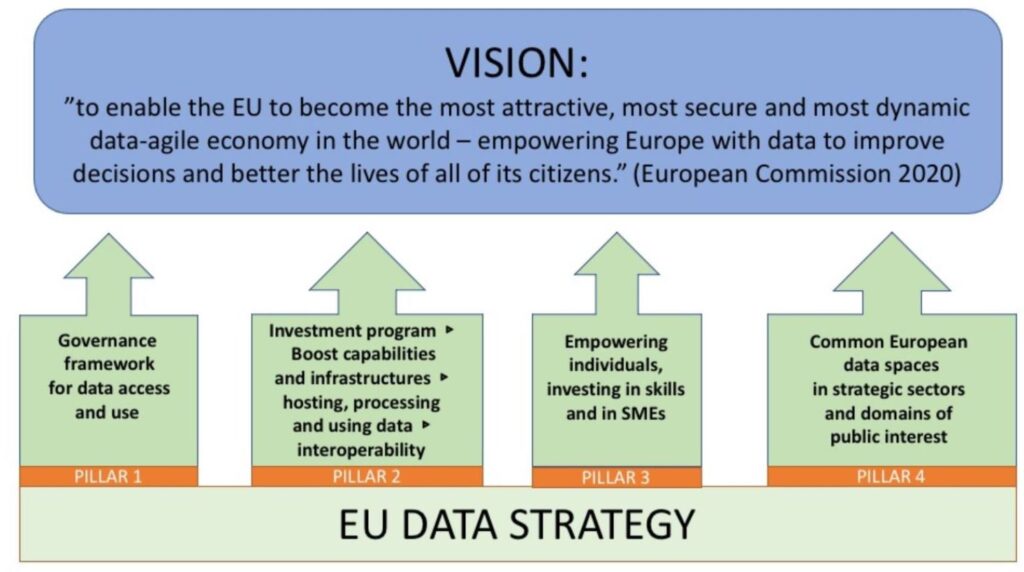
European Union is on a path to creating the European alternative for the data economy. The political need for digitalization and the data economy can be seen in the multiple initiatives and programs that the European Commission is launching and funding. This article focuses on one of the newest additions to the European Data Strategy, common European data spaces for cultural heritage, and how the emerging possibilities related to it could lead the way to innovative solutions.
Authors: Timo Oiva & Brett Fifield
European Union Data Strategy that was released in 2020 is a set of visions, actions, and goals compiled in one document (European Commission 2020). To summarize the values behind the strategy a direct quote will reveal the thinking: “In order to release Europe’s potential, we have to find our European way, balancing the flow and wide use of data, while preserving high privacy, security, safety and ethical standards” (European Commission 2020, 3).

Figure 1. European Union Data Strategy visualization (European Commission 2020, 11)
The European Union Data Strategy is built upon 4 different pillars of action. (European Commission 2020, 11). Pillar four (see Fig.1) is about common European data spaces. For the common European data spaces, the EU has named nine verticals that were chosen on the assumption that the use of data in those sectors will have a systematic impact on the whole ecosystem and on the lives of the citizens (European Commission 2020, 21). The verticals chosen by the EU are the following: Industrial, Green Deal, Mobility, Health, Financial, Energy, Agricultural, Public administration, and Skills. As mentioned in the EU’s Data strategy, there can be additional verticals. As of May 2022, the EU has already recognized the need for two additional common European data spaces – media and cultural heritage. (European Commission 2022, 1)
The deployment of the common European data space for cultural heritage is on its way as the Commission’s recommendation on it was adopted in November 2021 (European Commission 2021). Through the development of the data space for cultural heritage, the Commission aims to strengthen the development of the needed infrastructure, support the creation of high-value datasets, improve the quality of content data and metadata, build skills for digitalization, develop standards and boost the networks of the cultural heritage sector (European Commission 2022, 39).
One contribution to the future data space for cultural heritage is the Culture Gems -project that is a free open-source interactive map that aims to capture diversities of culture in European cities (European Union 2022). This means that individuals and organizations alike can add their favorite places and local stories behind real-world locations. For small cities like Lahti and Lappeenranta, this creates a possibility to promote the local culture and creative areas on a European scale map. Unfortunately, at the time of writing this, there are no entries for Lahti and Lappeenranta regions. Maybe Lab & LUT students can change this in the future!
In line with the open innovative nature of the data space concept, it is time to innovate some use possibilities for the data space for cultural heritage.
Virtual traveling promotes sustainable tourism
Cultural heritage is essential for tourism. Cultural tourism has a massive role in tourism in Europe, contributing up to 40 % of all tourism in Europe (World Tourism Organization 2018).
If the cultural heritage sites are 3D-modeled for the data space of cultural heritage, this could create opportunities for virtual tourism. In a world where the carbon footprint is measured and pandemics create barriers to traveling, there could be enormous untapped potential in the virtual traveling of using the data of local cultural heritage and re-using the data available in the data space. This new online access to the cultural heritage of the whole of Europe could boost tourism, not only in virtual aspects but also via hybrid forms including the usage of Virtual and Augmented reality on the actual sites. This could also create professions like Virtual Tour guides, Augmented reality designers for tourism, and 3D -modelers of sites and objects.
Cultural heritage data space bringing value to the health data space
One goal for the creation of common data space for cultural heritage is the reuse of 3D digitized cultural heritage assets in important domains such as education, social sciences and humanities, tourism and the wider cultural and creative sector. (European Commission 2021, 5; European Commission 2022, 39).
On the other hand, the initiative for the European Health Data Space aims to create an environment “for informed, evidence-based decisions to improve the accessibility, effectiveness, and sustainability of healthcare systems” (European Commission 2022, 20)
Maybe these data spaces could be bridged so, that cultural content could be re-used in an accessible and sustainable way to have the needed affect in healthcare? Virtual local sights could be used to create stimulating virtual reality tours for long-term patients who are unable to participate in activities outside their care unit. These groups of patients could include elderly citizens but also citizens in various sorts of rehabilitation. It is also a question of inclusiveness; do we want to give access to the data economy for all citizens? We need more information and research about virtual and augmented reality, cultural heritage and long-term care patients.
Use and re-use of cultural heritage content for design
What could the common European data space offer from the perspective of design? For example, it could be used to create a massive library of 3D-models. This library of 3D-models could be potentially anything from furniture to glassware, from interior design to patterns. Take project Europeana, which is web portal sharing and promoting European cultural heritage (Europeana 2020). Europeana has more than 52 million cultural heritage assets but sadly, only 0.03% percent of these assets are in 3D (European Commission 2021, 5). We can clearly see that there is a massive gap in 3D assets! Maybe in the future the amount of 3D assets increases. And maybe there could be a possibility to re-use these models in a way that makes it possible to connect and merge various elements with automatic licensing of immaterial property rights? Or could these models be possibly used in the “metaverse”, both commercially and creatively?
European Commission’s recommendation for the development of a common European data space has put a lot in motion – the seeds of the future are planned and visioned as we speak. These seeds could be also studied and researched further using various futures work methods as seen in the common European data space -related thesis by Oiva (2022).
European Commission’s recommendation for the development of a common European data space has put a lot in motion – the seeds of the future are planned and visioned as we speak. LAB University of Applied Sciences has all the needed skills and faculties to jump into the deep end – the deep end of this data pool. The real-life solutions and innovations can emerge from our actions. This a wonderful opportunity to collaborate and innovate together.
References
European Union. 2022. Cultural Gems. Cited 25 May 2022. Available at https://culturalgems.jrc.ec.europa.eu/
European Commission. 2020. Com (2020) 66 final. Communication from the Commission to the European Parliament, the Council, the European Economic and Social Committee and the Committee of the regions. A European strategy for data. Cited 25 May 2022. Available at https://eur-lex.europa.eu/legal-content/EN/ALL/?uri=CELEX:52020DC0066
European Commission. 2021. Commission Recommendation of 10 November 2021 on a common European data space for cultural heritage. Cited 25 May 2022. Available at https://ec.europa.eu/newsroom/dae/redirection/document/80911
European Commission. 2022. SWD (2022) 45 final. Commission staff working document on Common European Data Spaces. Cited 25 May 2022. Available at https://digital-strategy.ec.europa.eu/en/library/staff-working-document-data-spaces
Europeana. 2020. About us. Cited 25 May 2022. Available at https://www.europeana.eu/en/about-us
Oiva, T. 2022. European Union Common Data Spaces and the future orientation of Finnish Copyright Stakeholders. Master’s Thesis for Lab University of Applied Sciences, Faculty of Business. Cited 10 June. Available at https://urn.fi/URN:NBN:fi:amk-2022053013110
World Tourism Organization. 2018. Tourism and Culture Synergies, UNWTO, Madrid. Cited 25 May 2022. Available at https://doi.org/10.18111/9789284418978
Authors
Timo Oiva is Master’s Student in the Business Faculty at Lab University of Applied Sciences.
Brett Fifield is Principal Lecturer in the Business Faculty at Lab University of Applied Sciences.
Illustration: https://pixabay.com/fi/photos/euroopan-unionin-lippu-eurooppa-4886120/
(Photo by Kon Zografos, Pixabay License)
Published 21.6.2022
Reference to this article
Oiva, T. & Fifield, B. 2022. Cultural heritage data space – an opportunity to innovate. LAB Pro. Cited and date of citation. Available at https://www.labopen.fi/lab-pro/cultural-heritage-data-space-an-opportunity-to-innovate/






